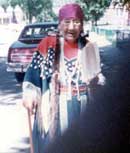 | | Museum at Warm Springs |
Our cultural heritage is as important and integral to us as the water we drink, the fish and roots we eat, and the sovereignty we reassert. For without our heritage, without the teachings handed down to us since time immemorial from our ancestors, the water, fish and roots would be without taste, and our right of sovereignty without merit. It is our cultural heritage that brings meaning to our lives, provides us with our unique identities, and helps define what we will become in the future. Our cultural heritage is who and what we are, as Wasco, as Warm Springs, as Paiute peoples.
Our cultural heritage includes our oral traditions and stories of Coyote and the other Animal Peoples and what they have taught us. It is the way we teach our children to dig the roots, to build the scaffolds and dip net for the salmon. It is the way we instruct our children to remember their elders and those in need as they share their first kill or first roots with them. Our cultural heritage includes the special places known and utilized by some families along the banks or falls of the rivers, on high desert plateaus, and in the forested mountains. It includes the baskets and tools our grandmothers made and used, the riding gear adorned with beadwork, the rifles once used to kill an elk by our grandfathers. Our cultural heritage is the names we give our children during a special naming ceremony and upon which our children will depend for their entire lives. It is our languages, it is our ceremonies, it is our natural resources, it is our sovereignty and right as an independent people to govern ourselves.
 | Maggie Wewa
One of the Grandmothers | It is for this reason that we place such great commitment and emphasis on the preservation and perpetuation of our cultural heritage. While each of our families are the ultimate caretakers of our cultural heritage, we also have established departments, programs and institutions to assist in this important effort. They include the Cultural Resources Department within the Branch of Natural Resources, the Culture and Heritage Department within the Department of Education, and our Museum at Warm Springs. We also rely upon all legal means to help enforce protection of our heritage, as in ARPA, the Archaeological Resources Protection Act, in NHPA, the National Historic Preservation Act, and in NAGRPA, the Native American Graves Protection and Repatriation Act.
At one time, our tribes did not have a museum. We had to store our valuable artifacts in the old Bureau of Indian Affairs school building. Because of security, only museum staff, and Culture and Heritage Committee were allowed to enter the small artifact room. So nothing was available to the people to view and remember. This photo is of the late Liz Tewee, museum curator. She had a dream of one day having a state-of-the-art museum for our tribes. We have come a long way since then, and now have a beautiful museum to store, protect and view our valuable artifacts and cultural heritage. Read from the transcript of a talk Liz gave in 1988, which includes a great overview of the tribes and current conditions.
One example of the desire to help assure that any cultural information shared publically is both authentic, as well as appropriate, a Cultural Property Rights Agreement was established between the Confederated Tribes of Warm Springs and the Lifelong Leanring Online Project. The agreement specifies an extensive review process by elders and the Tribal Council before this module is published and made available to the public. It also specifies that the materials contained within the module are the "cultural property" of the tribes and that the tribes have the continued right to monitor and change its content, if they so desire.
© Confederated Tribes of Warm Springs 2003
< previous | next > |



